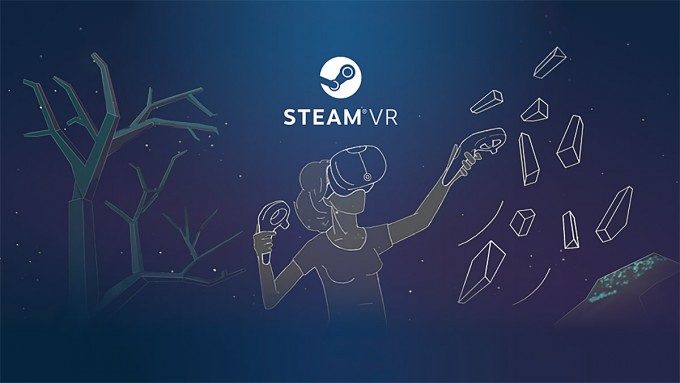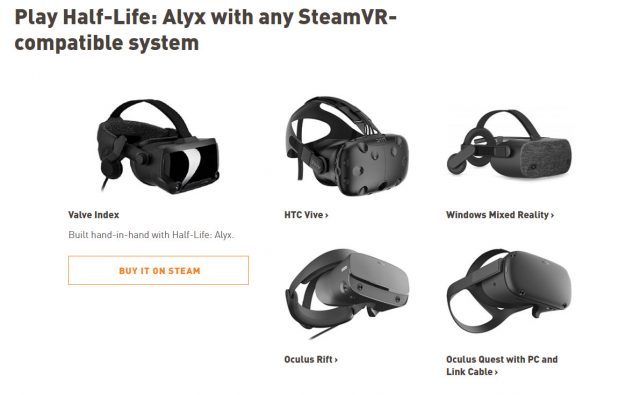
With the highly anticipated launch of Half-Life: Alyx just days away, it feels like an appropriate time to look at Valve’s unique commitment to ensuring that SteamVR remains a hardware-agnostic platform for VR content, and how the company has taken a near-opposite approach to Oculus which has built a closed ecosystem only compatible with the company’s own headsets.
Many Oculus Rift and even Quest owners know well that SteamVR supports both headsets seamlessly. But few realize that without Valve’s explicit support, this wouldn’t be the case.
While other headset makers and platforms like HTC, Windows VR, and Pimax all build and maintain their own software integrations to make their headsets work with SteamVR, it’s Valve, not Oculus, which develops and maintains the integration which allows the Rift and Quest to work on the platform.

I spoke with a source with direct knowledge of the Oculus SteamVR integration who told me that the integration is solely the work of Valve. They also said that on multiple occasions Valve offered for Oculus to take over the integration but never received a response.
Keeping the integration updated and bug-free is a collaborative effort at Valve, the source said, where developers who spot bugs or read about them from users online would often take it upon themselves to fix the issues or update the integration with new versions of the Oculus runtime to enable new features like Oculus Dash.
Without Valve spending its own time and development resources on building, maintaining, and updating the integration, Oculus’ headsets wouldn’t be compatible with SteamVR, and Oculus users wouldn’t be able to play Half-Life: Alyx or any of the platform’s content.
Now I’m not saying that a closed ecosystem like Oculus’—which is only officially compatible with the company’s own headsets—is invalid or evil. But I do think that Valve’s unique commitment to fostering an open VR platform is a boon for the industry as a whole.
While Oculus has never made any changes to their runtime that sought to block the Oculus SteamVR integration, the company attempted the inverse; when community developers first built the unofficial ‘Revive’ mod (which makes SteamVR headsets like Vive and Windows VR work with Oculus content), Oculus actively attempted to block the mod from working. Eventually they reneged, and have tacitly tolerated the mod since.
Valve, on the other hand, has created a platform which serves to enable VR more than control it, by not acting as a gatekeeper to content or hardware that operates on the platform.
You can see this commitment in many of the moves Valve has made with SteamVR over the years, right down to the way that they ensured that Half-Life: Alyx is tested and functional with all SteamVR compatible headsets—including building the integration necessary for Rift and Quest—even going as far as directly advertising competitor’s products on the game’s website right alongside their own Index headset.
 While Oculus had said that it would open its tracking system to third-party accessories and “go big” on allowing third-party headsets onto its platform, neither have come to pass by 2020.
While Oculus had said that it would open its tracking system to third-party accessories and “go big” on allowing third-party headsets onto its platform, neither have come to pass by 2020.
Meanwhile, anyone could build and launch a new VR headset tomorrow by tapping into Valve’s OpenVR API, and make the headset compatible with SteamVR and all of its content without so much as an email to Valve.
The open nature of SteamVR Tracking—which also has no Valve gatekeeping—means that companies can build interesting accessories that leverage the existing, high-performance tracking system used by many headsets. That’s enabled things like Logitech’s VR Ink stylus, the Vive Cosmos External Tracking Faceplate, the Vive Tracker, the Tactical Haptics controller, and even leaves the door open for academic and DIY experimentation.
Oculus’ tracking system, on the other hand, has remained closed to third-party usage, preventing things like third-party controller or other tracked accessories from being used with the company’s headsets.
After being acquired by Facebook, the Oculus playbook has been all about building and maintaining control of a closed VR ecosystem. This strategy was laid bare in emails by Facebook CEO Mark Zuckerberg who said the goal of acquiring Oculus was “not only to win in VR / AR, but also to accelerate its arrival.”
But, it isn’t Valve or any of the other VR players which Facebook perceives as the rivals against which it hopes to “win,” rather, it’s the other big tech giants. As a company whose users access apps and services in a large part through mobile phones running iOS or Android, Facebook is beholden to the whims of Apple and Google. Owning both the platform and the key apps means deep control over an ecosystem, and when it comes to AR and VR, Zuckerberg wants that power in Facebook’s hands rather than its competitors.
“From a timing perspective, we are better off the sooner the [VR / AR] becomes ubiquitous and the shorter the time we exist in a primarily mobile world dominated by Google and Apple. The shorter this time, the less our community is vulnerable to the actions of others,” Zuckerberg wrote. “[…] By accelerating this space, we are de-risking our vulnerability on mobile.”
Valve, on the other hand, has taken unprecedented steps—right down to maintaining support for a competitor’s headset—to ensure its platform remains an enabler of the VR ecosystem. Ironically, while Oculus has done the opposite in an effort to carve out its walled garden, it’s Valve’s open approach which has so far kept the company as a major player in the VR space.
The post Without Valve, ‘Half-Life: Alyx’ Wouldn’t be Compatible with Rift or Quest appeared first on Road to VR.
Ream more: https://www.roadtovr.com/without-valve-oculus-headset-play-half-life-alyx-rift-quest/
No comments:
Post a Comment